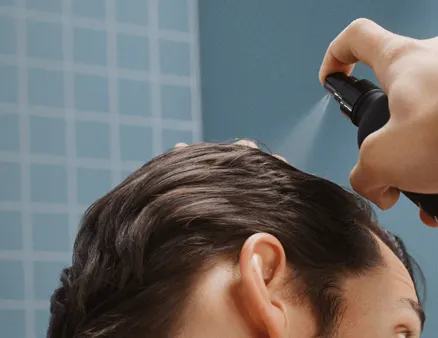Here's what we'll cover
Here's what we'll cover
Hair loss (or alopecia) is a problem that affects over 80 million people in the United States; this can cause psychological and social distress to both men and women (NIH, 2015). While there is no cure for this condition, there are hair loss solutions to camouflage hair loss.
Scalp micropigmentation (SMP) is one such option and has grown in popularity since it was first introduced in the early 2000s. It is a form of cosmetic tattooing that works by placing pigment (ink) in the deep layers of the skin; similar techniques include microblading to fill out eyebrows and permanent makeup. SMP makes a stippled pattern on the scalp by placing microdots less than 1 mm in size, decreasing the contrast between hair and skin, and creating the illusion of fuller hair (Rassman, 2015). The goal is for the microdots to look like hair follicles, the specialized structures in your scalp that produce hair.
Procedure
Scalp micropigmentation uses standard tattooing instruments with several microneedles to create the stippling on the scalp. It is crucial to have a skilled tattoo artist performing the SMP. Every patient is different and the skin on the various parts of the scalp is not the same, so the tattoo artist needs to be able to make technical and artistic changes as he or she performs the procedure. If the pigment is placed too deep, it will become blotchy; if it is too shallow in the skin, it will bleed out.
SMP usually requires two to four sessions, several weeks apart, that can last anywhere from four to eight hours to be successful. SMP can cost anywhere from $1800-$4000 per session, depending on the practitioner, the amount of tattooing needed, scalp scarring from other procedures , etc.
What should you do after SMP treatment?
For the first two to four days after your treatment session, avoid showering or touching your scalp.
Do not perform activities that cause excessive sweating or expose your head to sunlight for two to four days.
After four days, start moisturizing your scalp, especially if you have another session scheduled.
In the first 30 days after your treatment, avoid direct sun exposure; wear a hat or sunscreen that is at least SPF 30.
Avoid swimming for 30 days after your last treatment and in between sessions.
Who should/should not get SMP?
SMP is a hair loss solution for people with many different types of alopecia. You may benefit from SMP if you have (Rassman, 2015):
Androgenic alopecia, also known as hereditary baldness; can be used for male or female pattern baldness
Scalp scars, from scarring alopecias or scalp surgery (hair transplant surgery, trauma, etc.)
Autoimmune hair loss, like alopecia areata
Chemotherapy-associated hair loss that doesn’t grow back
“Failed” hair transplant (hair does not look as full as you would like)
The SMP tattooing process does cause some irritation and you should not have it done if you have inflammation in your scalp, like scalp acne, eczema, or psoriasis.
Potential risks and side effects
SMP does not treat the various causes of hair loss. Instead, it camouflages the thinning hair by decreasing the contrast of skin and hair; it is a cosmetic procedure. However, like any procedure, you need to know the risks (Rassman, 2015):
Infection from contaminated inks or needles, which can include bacterial or viral infections (like human immunodeficiency virus or hepatitis)
Allergic reactions to pigment ingredients
MRI complications (from metals that may be present in the ink)
Poor cosmetic results
To minimize these risks, make sure that you seek out a competent practitioner. There is no specific nationwide certification for SMP; the certification requirements vary by state. In some areas, little to no training may be required before someone can perform SMP. Since it is a complicated process that involves adjusting techniques based on your skin, you should consult with someone who has had a lot of experience with SMP.
There are other disadvantages to the scalp micropigmentation procedure. SMP is a relatively permanent procedure; however, you may need touch-ups over time as the pigment naturally fades. Also, you need to keep your hair color consistent with the color of the scalp pigment for the best effect; if you have graying hair, you will need to dye your hair continually to maintain the same visual effect.
DISCLAIMER
If you have any medical questions or concerns, please talk to your healthcare provider. The articles on Health Guide are underpinned by peer-reviewed research and information drawn from medical societies and governmental agencies. However, they are not a substitute for professional medical advice, diagnosis, or treatment.
National Institutes of Health (NIH) Androgenetic alopecia - Genetics Home Reference - NIH. (2015, August). Retrieved Oct. 4, 2019, from https://medlineplus.gov/genetics/condition/androgenetic-alopecia/#statistics
Rassman, W. R., Pak, J. P., Kim, J., & Estrin, N. F. (2015). Scalp Micropigmentation. Journal of Clinical and Aesthetic Dermatology , 8 (3), 35–42. Retrieved from https://www.ncbi.nlm.nih.gov/pmc/articles/PMC4382144/#__ffn_sectitle










